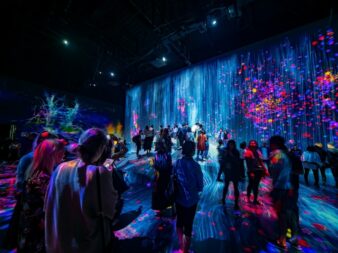In today’s world of social media, high-definition visuals and cutting-edge tech, museums need to go the extra mile when it comes to creating buzz and exciting their visitors. Looking for a sure-fire way to get your visitors engaged and talking about what you’ve got on show? Immersive exhibitions are your answer.
In a recent Tiqets webinar on immersive exhibitions in the COVID era, representatives of two museums, IDEAL Barcelona and The Forum of Augustus, shared how they use immersive exhibitions to captivate audiences and transport them to different worlds and different times. And with travel on the scarce side these days, who wouldn’t want to experience a whole new world without the help of a magic carpet or some high-speed transport?
Meet the immersive exhibitions experts

Jordi Sellas i Ferrés | IDEAL
IDEAL is a digital arts centre housed in a historic cinema. Their audiovisual art collection provides visitors with a completely immersive artistic experience. The centre doubles as a production studio for digital artists, so all the works found throughout the museum are developed in the centre’s own production facility.
The immersive exhibition they’re currently showing is Barcelona Memoria Fotografica, which translates to the “photographic memory of Barcelona”. The experience links analog photography with six of the biggest photographic artists in Barcelona today. The main theme of the exhibition is the city of Barcelona in the '50s and '60s through the eyes of the six photographers.

Riccardo Capone | The Forum of Augustus & The Forum of Caesar
The Journeys Through Ancient Rome project began in 2014 and has seen more than 700,000 visitors. The Forums of Augustus & Caesar offer visitors the chance to enjoy a journey through ancient Rome using virtual reality (VR) and augmented reality (AR).
Today, the Forum of Augustus is a large plot of land in Rome. Without VR headsets, that’s all you see: a fairly empty space in the middle of the city of Rome. But with VR headsets, the stadium that existed there centuries ago comes to life with sounds, lights and projections of people sitting in a 200-seater amphitheatre cheering on gladiators and chariot riders. The Forum of Caesar is a similar concept, and is currently under construction.
Key takeaways about immersive exhibitions
1. Don’t be intimidated by the tech involved, but don’t underestimate it

Both speakers stressed that using technology to create immersive experiences is entirely possible, and it’s becoming more and more affordable – but the process is not without its hurdles.
If you’re offering a VR experience where people can walk around your venue and see the space differently through their VR headsets, make sure your WiFi is up to the task – and be prepared to use a whole lot of cables.
“We use a mixture of augmented and virtual reality to turn large outdoor areas into virtual Ancient Rome spectacles. Some of the areas we use are as large as 90,000 square meters. It’s really challenging to cover all that space with virtual and augmented reality features – we had to roll down miles of cables in an area where, up until we got there, you weren’t allowed to place anything,” explained Riccardo Capone.
VR technology in museums can prove challenging. “If you’ve never worked with VR, running a large quantity of the headsets at this same time is very tricky. You need to control a lot of online traffic and make sure that each person’s VR experience is running seamlessly,” cautioned Jordi Sellas.
Despite these challenges, both speakers believe that technology is ultimately a friend, not a foe. “The growing quality of technology means that it is becoming cheaper and cheaper to offer an immersive exhibition and it has less and less impact on the monuments you’re creating around. We still have to solve a lot of practical and technical issues, but we are much better at that now than we were a decade ago,” said Capone.
2. COVID-19 can affect how you offer your immersive experience – but you can still offer one

Worried that no one will be able to use your carefully crafted immersive exhibition in the COVID era? While the restrictions may change how you share the exhibition, they needn’t impact your ability to share one.
In IDEAL’s case, their immersive exhibitions have remained open and they’ve had to make just a few adjustments to ensure their immersive offering is COVID-compliant. They’ve limited the number of people allowed in their main hall – which can even improve the immersive experience of it – and they’ve had to add an extra sanitisation step to each pair of VR goggles.
“We thought COVID-19 would bring huge challenges to our virtual reality section, because we weren’t sure how to make people feel safe using VR headsets that other visitors had used, too. We ended up creating paper masks that visitors had to put on before putting on the VR headsets. We were afraid the masks would put people off the experience, but many of them felt really safe and were grateful we’d taken those extra measures. So it paid off!” said Sellas.
Although The Forums of Augustus and Caesar have had to close recently because of new restrictions in Rome, they were both able to continue to operate before these new restrictions with just minor adjustments. “We didn’t have to change the immersive exhibitions themselves, all we had to do was change the way people use them. For example we moved from wireless headsets to disposable ones.
“To help people feel safer we introduced measures like temperature checks and we limited our capacity. Even if some measures are not strictly necessary, they’re good because they show your visitors that you care about their well-being.” explained Capone.
3. Size doesn’t matter

If you thought you needed a stadium-sized space to put on an immersive exhibition, think again.
At IDEAL, the immersive experience is offered in two ways. The first is through the use of a 1,000-square-metre hall with images projected onto the walls and floors. Walking through this hall, visitors feel like they’re completely surrounded by art. The second immersive exhibition they offer is one through VR headsets. The room in which the VR experience is offered is far smaller than their main hall – and it doesn’t need to be any bigger, as this immersive exhibition takes place within a pair of goggles no wider than a face.
Because of the many different options available when it comes to creating an immersive exhibition, the size of your venue does not limit you. Even if your venue is a small one, you can use augmented or virtual reality tools to create an immersive experience.
4. Immersive exhibitions are suited to both local and international audiences

Another great reason to create your own immersive exhibition? It’s a selling point for both local and international audiences.
Right now, you may not be welcoming too many international visitors to your museum, but that may change in a few months' time. So instead of developing something that caters to only one kind of audience, why not create something that will resonate with many kinds?
IDEAL’s immersive exhibitions are a sight to behold for both local and international audiences. “We are a local-based art centre, we’re not centered in tourism. Because we want our local audience to come back regularly, we try to tell a lot of stories with our exhibitions and we change exhibitions quite often. For example, we started with an exhibition based on Monet and Impressionism, and now we’re showing a photographic history of Barcelona. These kinds of exhibitions will be interesting to both locals and international visitors,” explained Sellas.
The Forums of Augustus and Caesar also started with a local focus that would entice internationals too. “We noticed that Rome lacked touristic or cultural things to do in the evenings, especially in summer time. We wanted to complete the tourist experience and offer locals something to do with their evenings. Because it needed to meet the standards of both locals and internationals, we involved a scientific journalist and his staff to create a compelling story and technology to go with it. We also offer the experience in many languages and throughout the day. And that’s how we ended up with something to meet the expectations of local and international visitors,” said Capone.
5. Don’t worry about convincing technophobes – they’ll come around
A lot of museums and attractions are concerned about adding an immersive exhibition to their offering as they’re worried it won’t appeal to an older audience – but if you create something that gets people talking, you’ll naturally attract a large audience.
“Word of mouth is your best advertising method when it comes to attracting local visitors. Once we’d established a connection with a few local Romans, people of all ages started coming to our immersive exhibition. Young men and women would bring their parents or grandparents, and they would recommend the exhibition to their friends – who would come and bring their children and grandchildren. It was like a circle of knowledge, and that was really interesting to witness,” said Capone.



